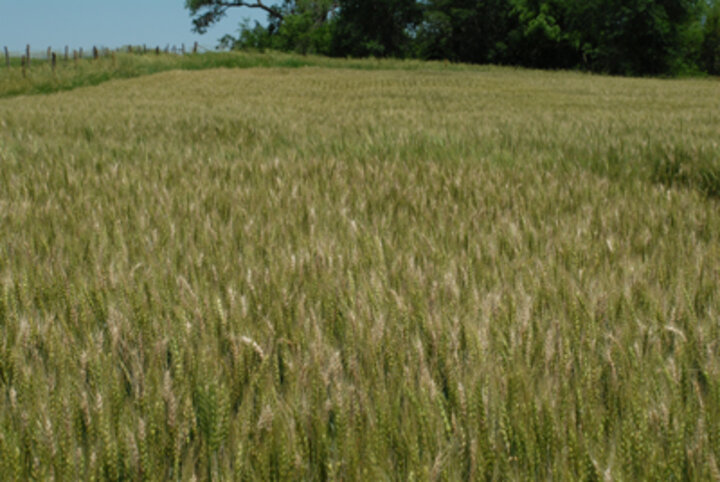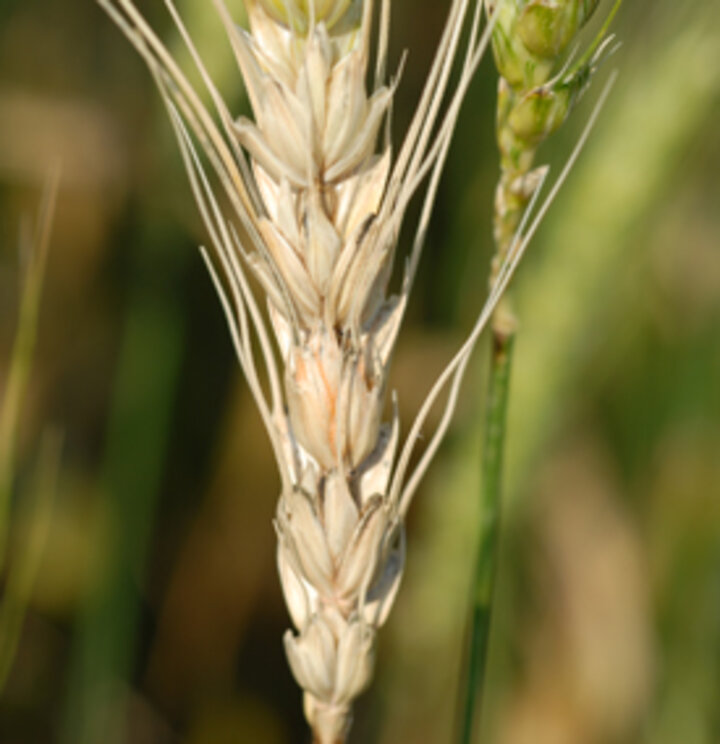
|
| Figure 1. Fusarium head blight in a grower's field in Saline County, June 16. (All photos by Stephen Wegulo) |

|
| Figure 2. This irrigated field east of Imperial had low severity (percentage of bleached spikelets on a head) of Fusarium head blight and medium incidence (percentage of diseased heads) on June 10. |
June 20, 2008

|
| Figure 3. A wheat head in an irrigated field east of Imperial with a few spikelets bleached by the Fusarium head blight fungus, June 10. |

|
| Figure 4. Progression of bleaching on a wheat head caused by the Fusarium head blight fungus. |

|
| Figure 5. A wheat head completely bleached by the Fusarium head blight fungus showing a pink to salmon spore mass on a spikelet. |
An unusually wet spring has favored development of scab or Fusarium head blight in Nebraska wheat fields for the second straight year.
The disease is especially prevalent in south central and southeastern Nebraska (Figure 1) but has shown up in wheat fields as far west as Imperial (Figure 2). In southwestern Nebraska, scab is more noticeable and incidence (percentage of infected heads) is higher in irrigated than in rain-fed fields.
Scab Symptoms
Symptoms of scab include premature bleaching of one or more wheat spikelets (Figure 3) or the entire immature head. Bleaching can start anywhere on the head and spread (Figure 4) until the entire head is bleached (Figure 5). With the continued wet weather, bleaching of infected wheat heads is expected to continue, which will increase disease severity.
| Also see Handling Scabby and DON-Affected Wheat Grain |
Scab has not been common in Nebraska in recent years due to drier than normal conditions; however, excessive rainfall in 2007 caused widespread occurrence of the disease in south central and eastern Nebraska. Similar weather conditions this year have favored development of scab in many wheat fields.
Disease Characteristics
The disease can be caused by several species of the fungus Fusarium and is favored by wet weather during the growing season. The fungus also causes stalk and ear rots in corn and seedling blights in cereal grains. It can survive in soil or on corn, wheat and grass stubble. Scab also is more severe in reduced or no-till fields, especially if wheat follows corn.Spores of the scab fungus are carried from fruiting structures on crop residues to wheat heads by air currents. Most infections occur during flowering because anthers and pollen serve as a food source for the fungus. Infected seed can transmit the fungus to emerging seedlings.
This can cause severe seedling blight under favorable conditions for disease development. During warm temperatures, blight symptoms on heads appear within two to four days after infection. Therefore, a crop that appeared healthy a few days earlier can suddenly show widespread symptoms.
Management
Scab can be managed by planting tolerant cultivars, rotating fields out of cereal grains or grasses, and using a fungicide application at early flowering. Most Nebraska wheat has already gone through the flowering stage, so it's too late to apply a fungicide to suppress the disease this year. Fungicides cannot be legally applied to wheat after flowering.
Fungicides

|
| Figure 6. Wheat grain with a high proportion of Fusarium-damaged kernels. |
Mycotoxins
In addition to lowering yields and grain quality, the scab fungus also can produce mycotoxins. The most commonly produced mycotoxin is deoxynivalenol or DON. Grain with a DON concentration exceeding 2 ppm usually will be discounted at the elevator. For more information on mycotoxins produced by the scab fungus and recommendations for using mycotoxin-contaminated feed, see the UNL extension publication Fusarium Head Blight of Wheat (EC1896).
Stephen Wegulo
Extension Plant Pathologist
